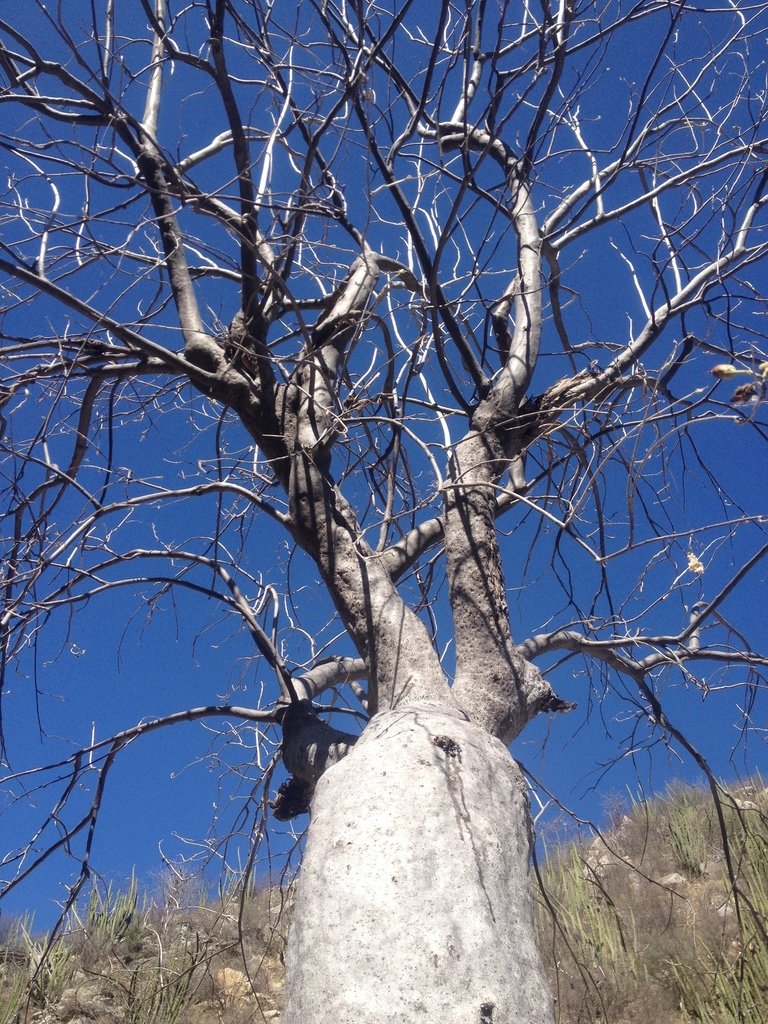Tree Morning Glory
Ipomoea arborescens
Family: Convolvulaceae
OTHER NAMES
Spanish: palo santo, palo blanco, palo muerto, palo bobo, ozote, casahuate blanco, palo cabra
Nahuatl: Cazahuatl
CHARACTERISTICS
Tropical, deciduous tree reaching almost 40’ tall with stout trunk and branches and large green leaves. This plant flowers during the winter and early spring before the leaves re-appear, often during the fall as well, and rarely, sporadically in summer. The tips of the branches are twining, echoing the vine-like growth form of most morning glories. There is an upper elevational variety (Ipomoea arborescens var. pachylutea) which occurs in the transition between tropical deciduous forest and oak woodland. It differs from the nominate variety (Ipomoea arborescens var. arborescens) in having a yellowish bark and harder wood, much larger and hairier leaves, and dark purple flower throats. It may be more cold-hardy.
LANDSCAPE USE
Specimen tree in a protected location, shrubby screen, or container plant.
Photo by Sky Jacobs, SEINET
Ipomoea arborescens on iNaturalist
GROWING CONDITIONS
AN EXPLANATION OF TERMS USED
SUN full to part sun
WATER moderate
SOIL not picky, but well-drained
HARDINESS hardy to about mid to upper 20s°F
BASIN high zone
CONTAINER does moderately well in containers but will not attain full size
NUTRITION low
MAINTENANCE very little
ECOLOGY
The flowers of Tree Morning Glory are a food source for hummingbirds, bees and long-nosed bats. Many insects and animals eat the fallen flowers.
ETHNOBOTANY
The seeds of plants in the Morning Glory family contain ergine a lysergic alkaloid, also known as LSD. Native Americans used this plant in their religious and medicinal ceremonies
NATURAL DISTRIBUTION
From Northwestern Mexico in the Sonoran Desert up into the Sierra Madre.
TAXONOMY AND NAME
Ipomoea comes from the Greek words ips which means “worm”, and homois, which means “similar to.” This refers to most species’ wormlike twining habit—even this species twines at the tips. The species name “arborescens” refers to the treelike nature of this species.
The foliage is willowy, and sometimes even twines like a vine at the tips of the branches, as if remembering genetically it's really a vine. Photo by César Rodríguez, iNaturalist
This species is somewhat of a caudiciform, a fat plant that stores moisture within its trunk. Photo of a dormant plant by Bodo Nuñez Oberg, iNaturalist
This species usually starts flowering when leafless in late winter, and into the spring. Sometimes they will flower more during the summer. Photo by chayito-tuga, iNaturalist
Flower detail, this is Ipomoea arborescens var. pachylutea that grows in the mountains. They have darker throats than the lower-elevation plants. Photo by Stephen Hale, SEINET
Ipomoea arborescens var. arborescens usually has a light yellow throat, and is found at lower elevations. Photo by Fraser Watson, iNaturalist
Carpels release seeds with hairy fringe. Photo by R.E.Llanos, iNaturalist
Another view of that fat trunk, photo by Aurelio Molina Hernández, iNaturalist








